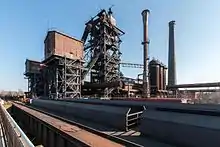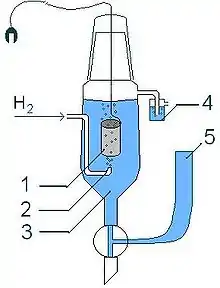Cool Earth 50
Cool Earth 50 (also known as Cool Earth) is a plan developed by Japan to reduce global CO2 emissions 50% by 2050, which was discussed at the 34th G8 summit. Cool Earth 50 is planned to be a framework that would continue towards the goals set forth in the Kyoto Protocols. This plan includes three proposals: a long-term strategy, a mid-term strategy and launching a national campaign for achieving the Kyoto Protocol Target.[1]
The plan was first proposed on May 24, 2007 at an international conference called Asian Future[2] and was initiated by Japanese Prime Minister Shinzo Abe.[2][3] The program's goal is to reduce current global green house emissions by 50% by the year 2050.[2] The goal of reduction was aimed particular towards the largest green house emitting countries The United States, China, Japan, and India. Also, for the major green house emitters to create a frame work for reduction.[4] Cool Earth aims at reducing green house emissions by improving technology in energy fields.[5] A large goal of Cool Earth is to promote economic prosperity through green technology and to encourage political stability domestically and internationally.[6]
Proposals
The proposals of this program include:
- A long-term strategy for global reduction of greenhouse gas emissions.
- Propose three principles for establishing an international framework for addressing global warming from 2013 onward.
- To launch a national campaign to ensure Japan achieves the Kyoto Protocol goal.[7]

In addition, the proposal sets to make technological advancements in:
- Zero-emissions coal-fired power generation
- Reactors for nuclear power generation
- Technology for high-efficiency and low-cost solar power generation
- Technology for the use of hydrogen
- Ultra high energy efficiency technology[5]
Course 50
Course 50 is a CO2 reduction strategy to reduce CO
2 emissions by 30%. The aim of Course 50 is to suppress CO
2 emissions from blast furnaces and to capture CO
2 from blast furnaces.[8] The goal is to reach reduction by the year 2030.[8] The programs first phase was initiated in the year 2008 and funded by New Energy and Industrial Technology Development Organization.The original budget was approximately 10 billion yen.[8] Course 50 is encouraging innovation in technology towards more effective CO
2 capturing polymers, as well as temperature reduction and improved efficiency of blast furnaces in the steel industrious.[9]
Solar

Japan with Cool Earth has been expanding their solar power industry offering subsidies to improving solar powered infrastructure. The main research goal is to achieve a low cost high efficiency solar cell that offers a conversion efficiency of 40%.[10]
Hydrogen power

In 2009, Japan fitted over 100,000 homes with hydrogen powered fuel cells, improving its hydrogen powered infrastructure.[11]
Energy efficient technology
New development of LED light bulbs that utilize blue and white light has improved efficiency by over 25% since 2008.[12] The use of SerDes router technology having the capability to reduce energy waste from routers by over 50%.[13]
References
- Invitation to "Cool Earth 50"
- Kikkawa, Takeo. Japan’s Contribution to Cool Earth. Technical Report. Tokio: Graduate School of Commerce and Management Center for Japanese Business Studies, Hitotsubashi University, 2009.
- Cool Earth 50
- Hamasaki, Hiroshi, and Tatsuyoshi Saijo. Designing Post-Kyoto Institutions: From the Reduction Rate to the Emissions Amount. mimeo, 2008.
- "MOFA: New Proposal on Climate Change, "Cool Earth 50"". www.mofa.go.jp. Retrieved 2016-12-15.
- Okano-Heijmans, Maaike. "Japan's ‘green’economic diplomacy: environmental and energy technology and foreign relations." The Pacific Review 25.3 (2012): 339-364.
- "Speeches and Statements by Prime Minister Shinzo Abe". japan.kantei.go.jp. Retrieved 2016-12-15.
- Tonomura, Shigeaki. "Outline Of Course 50." Energy Procedia 37.GHGT-11 Proceedings of the 11th International Conference on Greenhouse Gas Control Technologies, 18–22 November 2012, Kyoto, Japan (2013): 7160-7167. ScienceDirect. Web. 14 Dec. 2016.
- Hayashi, Mikihiro, and Tomohiro Mimura. "Steel Industries in Japan Achieve Most Efficient Energy Cut-off Chemical Absorption Process for Carbon Dioxide Capture from Blast Furnace Gas." Energy Procedia 37 (2013): 7134-7138.
- Lewis, Joanna, Amber Sharick, and Tian Tian. "International motivations for solar photovoltaic market support: findings from the United States, Japan, Germany and Spain." Prepared for the center for resource solutions and the energy foundation china sustainable energy, program (2009).
- "Japan eyes Hydrogen Future". www.renewableenergyworld.com. Retrieved 2016-12-16.
- Su, Shi‐Jian, et al. "Highly efficient organic blue‐and white‐light‐emitting devices having a carrier‐and exciton‐confining structure for reduced efficiency roll‐off." Advanced Materials 20.21 (2008): 4189-4194.
- Yamada, Masaki, et al. "Power efficient approach and performance control for routers." 2009 IEEE International Conference on Communications Workshops. IEEE, 2009.
External links
- Cool Earth 50 at the Japanese Ministry of Foreign Affairs
- "Cool Earth 50" welcome (in Nihongo), 2007